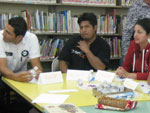Targeting Content and English Language Objectives

Integrating English Language Development (ELD) standards and objectives into your lesson planning can strengthen both your students' understanding of history and their language skill levels.
For many students, meeting content goals can be particularly difficult as many do not have the academic English skills necessary to access the history content. Therefore, it is important that teachers integrate ELD standards with their history content goals and lesson plans, so students can improve their language skills and proficiency as well as their historical understanding.
Effective lesson plans that target content and English language objectives start with content objectives. Decide on the topic, history content standard, and history objectives first. Then, determine the ELD objectives that compliment the content goals. In doing so, choose ELD objectives that all students should meet. Differentiate for skill levels by adjusting work products that match students' abilities.
Remember, if you are creating both ELD and content objectives, they should be assessed separately. Content objectives are measured by how well the students understood the material, whereas ELD objectives are measured by how effectively the students communicated their understanding.
The following example, written for a California 8th-grade U.S. History classroom, outlines how you might approach this process.
- Decide on the topic: For example, the causes of the Mexican-American War (1846–1848)
- Identify the relevant content standard: California U.S. History Standard 8.8 asks students to analyze the divergent paths of the American people in the West from 1800 to the mid-1800s and describe the Mexican-American War.
- Create history content objectives: Students will identify multiple causes of the Mexican-American War.
- Create the assignment/task: In small groups, students will read the section on the Mexican-American War from two different textbooks. Students compare the passages with the help of a graphic organizer.
- Identify the language demands of the task: Students will need to be able to identify and understand the cause-effect relationships in each text. They will need to be able to compare the causes identified by each account in small-group discussion.
- Create ELD objectives that all students should meet: Students will read both texts and identify, orally and in writing, the war's causes in each. Students will be able to use their graphic organizers to compare and contrast texts. Reference ELD standards in your state to find appropriate objectives.
- Assess content and ELD objectives differently: To quickly assess for ELD skill level, students will provide answers orally or in written form, using group discussion and their graphic organizers. ("Reporters" and "Recorders" can be assigned or self-selected prior to the start of group work.) Groups can also be monitored during discussion to assess members' listening and speaking participation and use of graphic organizers. Content understanding can be assessed through the review of the substance of these answers.
Many states have ELD standards, although the name may vary from state to state. What may be called English as a Second Language in one state may be called English Language Proficiency in another state. Despite this difference, all of the standards focus on English language acquisition.
Check your state's department of education website for ELD standards and other resources. If your state does not have them, the state English Language Arts standards can substitute. Below are sample state ELD standards.
California English Language Development Standards
New York Learning Standards for English as a Second Language